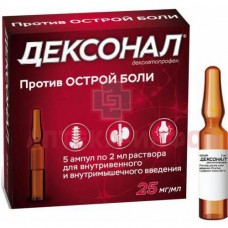Expiration date: 12/2026
Composition
active ingredient: dexketoprofen trometamol — 73.8 mg, in terms of dexketoprofen 50 mg;
excipients: ethanol (ethyl alcohol) 95%, sodium chloride, sodium hydroxide solution 1 M, water for injection.
Pharmacotherapeutic group
nonsteroidal anti-inflammatory drug (NSAID)
Indications
Musculoskeletal pain (mild or moderate), algodismenorrhea, toothache
The drug is intended for symptomatic treatment, reducing pain and inflammation at the time of application.
Contraindications
- hypersensitivity to dexketoprofen, other components of the drug and other NSAIDs;
- a complete or incomplete combination of bronchial asthma, recurrent polyposis of the nose and paranasal sinuses and intolerance to acetylsalicylic acid or other NSAIDs (including in the anamnesis);
- erosive and ulcerative lesions of the gastrointestinal tract in the acute stage;
- a history of gastrointestinal bleeding or perforation, including those associated with previous use of NSAIDs;
- gastrointestinal bleeding; other active bleeding (including suspected intracranial hemorrhage);
- inflammatory bowel diseases (Crohn's disease, ulcerative colitis) in the acute stage;
- severe liver failure (10-15 points on the Child-Pugh scale);
- progressive kidney disease, confirmed hyperkalemia;
- chronic kidney disease: stage 3a (glomerular filtration rate (GFR) 45-59 ml/min/1.73 m2), 3b (GFR 30-44 ml/min/1.73 m2) and 4 (GFR <30 ml/min/1.73 m2);
- the period after coronary artery bypass grafting;
- severe heart failure (NYHA class III –IV);
- hemorrhagic diathesis and other blood clotting disorders;
- age under 18 (due to lack of data on efficacy and safety);
- pregnancy and breastfeeding.
With caution
Gastric and duodenal ulcer, ulcerative colitis, Crohn's disease, a history of liver disease, hepatic porphyria, chronic kidney disease, stage 2 (GFR 60-89 ml/min/ 1.73 m2), chronic heart failure, hypertension, significant decrease in circulating blood volume (including after surgery), elderly patients over 65 years of age (including receiving diuretics, weakened patients and patients with low body weight), bronchial asthma, simultaneous administration of glucocorticosteroids (including prednisolone), anticoagulants (including warfarin), antiplatelet agents (including acetylsalicylic acid, clopidogrel), selective serotonin reuptake inhibitors (including citalopram, fluoxetine, paroxetine, sertraline), coronary heart disease, cerebrovascular diseases, dyslipidemia/hyperlipidemia, diabetes mellitus, peripheral artery diseases, smoking, the presence of Helicobacter pylori infection, systemic lupus erythematosus (SLE) and other systemic connective tissue diseases, long-term use of nonsteroidal anti-inflammatory drugs, tuberculosis, severe osteoporosis, alcoholism, severe somatic diseases.
Method of administration and dosage
The method of application and dosage regimen of a particular drug depend on its form of release and other factors. The optimal dosage regimen is determined by the doctor. The compliance of the used dosage form of a particular drug with the indications for use and dosage regimen should be strictly observed.
For oral administration, the average single dose is 12.5 mg - 1-6 times / day every 4-6 hours as needed or 25 mg 1-3 times / day every 8 hours. The maximum daily dose is 75 mg. The duration of application is no more than 3-5 days.
Side effects
Possible side effects are listed in accordance with the classification of the World Health Organization below in descending frequency of occurrence: very often (greater than or equal to 1/10); often (greater than or equal to 1/100, <1/10); infrequently (greater than or equal to 1/1000, <1/100); rarely (greater than or equal to 1/10000, <1/1000); very rare (< 1/10000), including individual messages.
From the blood and lymphatic system
Very rare: neutropenia, thrombocytopenia.
On the part of the immune system
Rarely: laryngeal edema.
Very rare: anaphylactic reactions, including anaphylactic shock.
From the nervous system
Infrequently: headache, dizziness, drowsiness.
Rarely: paresthesia, syncopal states (transient short-term fainting).
From the side of the psyche
Infrequently: insomnia, feeling of anxiety.
On the part of the organ of hearing and labyrinthine disorders
Infrequently: vertigo.
Very rare: tinnitus.
From the side of the organ of vision
Very rare: blurred vision.
From the cardiovascular system
Infrequently: palpitations, feeling of heat, hyperemia of the skin.
Rarely: increased blood pressure.
Very rarely: tachycardia, decreased blood pressure.
From the respiratory system
Rarely: bradypnea.
Very rarely: bronchospasm, shortness of breath.
From the gastrointestinal tract
Often: nausea, vomiting, abdominal pain, dyspepsia, diarrhea.
Infrequently: gastritis, constipation, dry mouth, flatulence.
Rarely: erosive and ulcerative lesions of the gastrointestinal tract (GI tract), bleeding from an ulcer or its perforation.
Very rare: pancreatic lesion.
From the liver and biliary tract
Rarely: hepatitis, increased activity of "liver" enzymes (AST and ALT).
Very rare: liver damage.
From the kidneys and urinary tract
Rarely: polyuria, acute renal failure.
Very rare: nephritis or nephrotic syndrome.
On the part of the reproductive system
Rarely: in women - menstrual irregularity, in men - transient dysfunction of the prostate gland with prolonged use.
From the musculoskeletal system
Rarely: back pain.
From the skin and subcutaneous tissues:
Infrequently: skin rash.
Rarely: urticaria, acne, increased sweating.
Very rarely: severe skin reactions (Stevens-Johnson syndrome, toxic epidermal necrolysis (Lyell's syndrome)), angioedema, facial edema, allergic dermatitis, photosensitization, itching.
From the side of metabolism:
Rarely: anorexia.
General violations:
Not often: increased fatigue, asthenia, chills, general malaise.
Very rare: peripheral edema.
As with other NSAIDs, the following side effects may develop: aseptic meningitis, which develops mainly in patients with systemic lupus erythematosus or systemic connective tissue diseases, hematological disorders (thrombocytopenic purpura, aplastic and hemolytic anemia, in rare cases — agranulocytosis and bone marrow hypoplasia).
Drug interaction
The following interactions are typical for all NSAIDs.
Undesirable combinations
With other NSAIDs, including salicylates in high doses (more than 3 g / day): simultaneous use of several NSAIDs due to the synergistic effect increases the risk of gastrointestinal bleeding and ulcers.
With anticoagulants: dexketoprofen, like other NSAIDs, can enhance the effect of anticoagulants such as warfarin due to its high degree of binding to plasma proteins, inhibition of platelet aggregation and damage to the mucous membrane of the gastrointestinal tract. If necessary, simultaneous use requires careful monitoring of the patient's condition and regular monitoring of laboratory parameters.
With heparin: with simultaneous use, the risk of bleeding increases (due to inhibition of platelet aggregation and damaging effects on the mucous membrane of the gastrointestinal tract). If necessary, simultaneous use requires careful monitoring of the patient's condition and regular monitoring of laboratory parameters.
With glucocorticosteroids: with simultaneous use, the risk of ulcerative lesions of the gastrointestinal tract and bleeding increases.
With lithium preparations: NSAIDs increase the concentration of lithium in blood plasma up to toxic in connection with which this indicator must be monitored when used with dexketoprofen, changing the dosage, as well as after the withdrawal of NSAIDs.
With methotrexate in high doses (15 mg/week or more): It is possible to increase the hematological toxicity of methotrexate due to a decrease in its renal clearance when used concomitantly with NSAIDs.
With hydantoines and sulfonamides: it is possible to increase their toxic effect.
Combinations that require caution
With diuretics, angiotensin converting enzyme (ACE) inhibitors, antibiotics from the aminoglycoside group, angiotensin II receptor antagonists: concomitant use with NSAIDs is associated with the risk of acute renal failure in dehydrated patients (decreased glomerular filtration due to reduced prostaglandin synthesis). With simultaneous use of NSAIDs, they can reduce the antihypertensive effect of some drugs. With simultaneous use of dexketoprofen and diuretics, it is necessary to make sure that the patient has no signs of dehydration, as well as to monitor kidney function at the beginning of simultaneous use.
With methotrexate in low doses (less than 15 mg / week): it is possible to increase the hematological toxicity of methotrexate due to a decrease in its renal clearance against the background of simultaneous use with NSAIDs. It is necessary to count blood cells at the beginning of simultaneous use. In the presence of impaired renal function, even to a mild extent, as well as in the elderly, careful medical supervision is necessary.
With pentoxifylline: there may be an increased risk of bleeding. Careful clinical monitoring and regular checking of bleeding time (blood clotting time) are necessary.
With zidovudine: there is a risk of increased toxic effects on red blood cells due to exposure to reticulocytes, with the development of severe anemia a week after the start of NSAID use. It is necessary to conduct a general blood test with a count of the number of reticulocytes 1-2 weeks after the start of NSAID therapy.
With oral hypoglycemic agents: NSAIDs can enhance the hypoglycemic effect of sulfonylurea preparations due to the displacement of sulfonylurea from the sites of binding to plasma proteins.
Combinations that need to be taken into account
With beta-blockers: when used concomitantly with NSAIDs, the antihypertensive effect of beta-blockers may decrease due to inhibition of prostaglandin synthesis.
With cyclosporine and tacrolimus: NSAIDs can increase nephrotoxicity, which is mediated by the action of renal prostaglandins. With simultaneous use, it is necessary to monitor kidney function.
With thrombolytics: the risk of bleeding increases.
The risk of gastrointestinal bleeding increases when used concomitantly with serotonin reuptake inhibitors (citalopram, fluoxetine, sertraline) and anticoagulants.
With probenecid: it is possible to increase the concentration of NSAIDs in blood plasma, which may be due to the inhibitory effect of probenecid on renal tubular secretion and/or conjugation with glucuronic acid; correction of the dose of NSAIDs may be required.
With cardiac glycosides: Concomitant use with NSAIDs may lead to an increase in the concentration of glycosides in blood plasma.
With mifepristone: due to the theoretical risk of changes in the effectiveness of mifepristone under the influence of prostaglandin synthesis inhibitors, NSAIDs should not be used earlier than 8-12 days after discontinuation of mifepristone.
With quinolones: data obtained in experimental animal studies indicate a high risk of seizures when using NSAIDs with quinolones in high doses.
Storage temperature
from 2? to 25?


